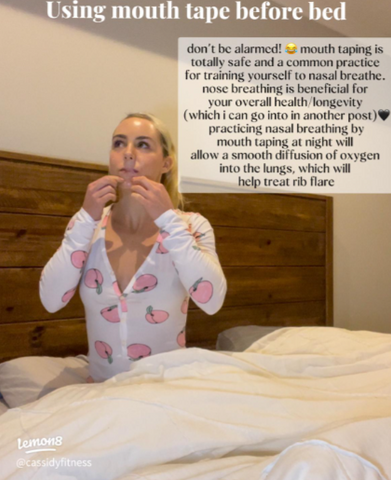Do you feel like your ribs protrude outward more than they used to?
Did you recently give birth and find that your rib cage doesn’t quite feel the same as it did before you were pregnant?
Or maybe you’ve felt your rib cage lift from your exercise mat while practicing yoga or a core workout.
This is known as a rib flare – and it’s setting you up for further injury in the future.
Why A Flared Rib Cage is Cause For Concern
If you’re unsure if you have a rib flare, turn to the side in front of a mirror.
Does your upper back have a curve or is it overly straight? Does your chest stick out when you stand or sit?
Stand against the wall with your feet a few inches away from the wall. Does your mid back touch the wall fully, or are your shoulder blades the only thing making contact with the wall?
These are all signs of a rib flare, along with upper body pain and stiffness.

A rib flare is typically a sign of core weakness or instability. When we feel this weakness during exercise, the body overcompensates by flaring the ribs little by little over time.
This is poor form and can lead to exercise-induced injury.
Rib flares can also occur as a result of pregnancy to accommodate for your growing baby. As your baby grows in the womb, the ribs may tip upward and out.
If you have a small or short torso, your risk for rib flare during pregnancy is typically higher than the average person.
Aside from poor form during workouts or pregnancy, a flared rib cage can also be genetic or may develop over time due to abnormal breathing patterns.
Regardless of the cause, a rib flare puts unnecessary stress on the neck, ribs, shoulders, and spine, causing pain, stiffness, and increased risk of injury.
All About the Zone Of Apposition (ZOA)
Good rib positioning includes an overlap of the diaphragm and abdominal muscles often called the zone of apposition or ZOA.
When your ribs become flared, the ZOA disappears.
This leads to poor diaphragmatic posture, poor breathing, and inadequate abdominal activation.
With a flared rib cage, it’s difficult to achieve a full exhale. Without proper exhalations, oxygen levels suffer.
But that’s not all: without proper oxygenation, you may be stuck in a constant state of “fight or flight.”
Slow, consistent breathing activates the parasympathetic “rest and digest” response, while shallow breathing does the opposite.
While a rib flare can cause shallow breathing, the opposite is true, too: shallow breathing may lead to rib flares.
When we breathe shallowly in the upper chest, the diaphragm remains unengaged. Over time, shallow breathing causes poor posture, worsening a pre-existing rib flare.
The Diaphragm: Use It or Lose It!
If you feel you suffer from a rib flare, poor posture, shoulder tension, and back pain, sub-optimal tongue posture and breathing patterns are likely worsening or initially causing these issues.
Take a moment to be mindful of how you breathe.
When you inhale, do your shoulders raise upward? Does your rib cage lift?
There should be no movement in the shoulders or chest when you inhale. Moreover, lifting the shoulders while you breathe leads to neck and shoulder stiffness.
Your diaphragm exists as your primary breathing muscle for a reason: it should ebb and flow low within your belly, matching the patterns of your breath.
During a functional inhale, the diaphragm contracts and lowers as your ribs move out horizontally (rather than vertically), allowing the lungs to expand and fill with air.
As the lungs expand, the space inside the rib cage decreases, creating a force that pulls air into the lungs without any extra effort on your body’s behalf.
When the diaphragm isn’t properly engaged, the body overcompensates by using muscles in the upper body to bring in air.
Mouth breathing consists of shallow, inconsistent breaths that don’t fully activate the diaphragm. Nasal breathing, however, leads to optimal oxygen delivery that utilizes the diaphragm efficiently.
Believe it or not, shallow versus deep breathing starts with the way the tongue is positioned within the mouth at rest.
Tongue Posture Influences Body Posture
Your tongue offers more than a sense of taste when it comes to your favorite foods and beverages.
The fascia underneath your tongue ties it to the rest of your body.
Fascia is a type of connective tissue that is shaped like a spider web, providing a network of structural support to muscles, bones, nerves, and organs.
The “sheet” of fascia under your tongue stretches down into the neck, chest, hips, knees, and more.
Therefore, less-than-optimal tongue posture and breathing patterns cause dysfunctional body posture and, in turn, dysfunctional rib placement.
When tongue posture is off, fascia tightens. Forward head posture, slouched shoulders, jaw pain, misalignment, and shallow mouth breathing follow.
Although mouth breathing and improper tongue posture are proven to cause misalignment across the body, most of us are habitual mouth breathers.
In fact, recent research found that it starts at a young age - 54 percent of young children are chronic mouth breathers.
Establishing and maintaining proper tongue posture is key to preventing shallow mouth breathing, poor body posture, rib flares, and more.
But what does proper tongue posture consist of?
Keep it Nasal With Correct Tongue Placement
The placement of our tongue while at rest affects our breathing, oral health, posture, and more.
In fact, tongue posture and poor breathing weren’t issues for ancient humans. Historically, we used to have large palettes and well-developed facial muscles that allowed the tongue ample space to rest properly.
In modern times, our airways have narrowed due to underdeveloped jaws and airway muscles. Why are these muscles so underdeveloped?
Our soft modern diet is one large contributing factor to these poorly developed muscles. Without ample chewing, our jaw muscles don’t develop as they should.
Evolutionarily, our skulls have shrank as a result, making proper tongue posture more difficult to achieve.
So what should optimal tongue positioning look like? According to most airway health specialists, proper tongue posture consists of sealed lips with slightly parted teeth.
The tongue should rest up against the roof of the mouth just behind the teeth, making contact at the tip, middle, and back of the tongue.
This position, sometimes called “mewing,” allows for fascia to rest in the proper position. This action decreases neck and jaw pain, reduces the chances of mouth breathing, and lowers the risk for rib flares, as a result.
Mouth breathing is also virtually impossible when the tongue rests in the optimal position, helping to leave shallow breathing in the past.
Is your tongue down on the floor of your mouth or up against the roof where it belongs? Are you breathing in and out of your mouth while reading this, or is nasal breathing part of your daily practice?
Nasal Breathing As A Rib Flare Remedy
Breathing in and out of the mouth through the upper chest is an adaptation that helps to keep us breathing when the diaphragm and airways are restricted, but it’s not healthy in the long term.
We take at least 20,000 breaths per day. If all of our oxygen is exchanged with the wrong muscles, long-term pain and problems follow.
Breathing efficiently in and out of the nose activates the diaphragm, eases tension, and may even help to reverse or improve a rib flare.
The nose and diaphragm work together to ensure proper oxygenation and activate our relaxation response.
As you begin to work on proper tongue posture mentioned above, focus on making habitual nasal breathing part of your daily practice.
Fitness influencer Cassidy Morgan credits mouth taping as part of her daily practice for rib flare correction.
“Practicing nasal breathing by mouth taping at night will allow a smooth diffusion of oxygen into the lungs, which will help treat rib flare,” she said in a post about rib flare correction.
Aside from mouth taping for the promotion of nasal breathing, Cassidy also recommends improving your posture, functional core training, and diaphragmatic breathing as part of a rib flare correction plan.
Daily diaphragmatic breathing exercises are a great place to start, as they activate the core by pulling the belly button into the spine.
Once you’ve mastered that, turn your attention toward active nasal breathing during both the day and night.
Tape Your Way Toward a Healthier Diaphragm
With some extra attention and mindfulness, you can begin to shift your breath from shallow to deep.
There’s just one problem: how do you ensure nasal breathing during sleep if you’re not conscious?
Mouth tape provides a lip seal specifically designed for sleep that prevents open-mouth snoring, enhances sleep quality, and will help to train your breathing patterns overnight.

Before you reach for any tape, beware! The chemicals within the adhesives of most tapes aren’t skin-safe.
SomniFix is different. Our Strips were created for even the most sensitive skin types. Our gel-like adhesive is comfortable and free of gluten and latex.
What’s more, our hypoallergenic Strips feature a patented central breathing vent to ease any hesitation you might have about wearing mouth tape while you sleep.
This backup mouth breathing option is there in case you need it in the event of overnight nasal congestion.
Improve your airway health and flared rib cage while you dream with SomniFix!








